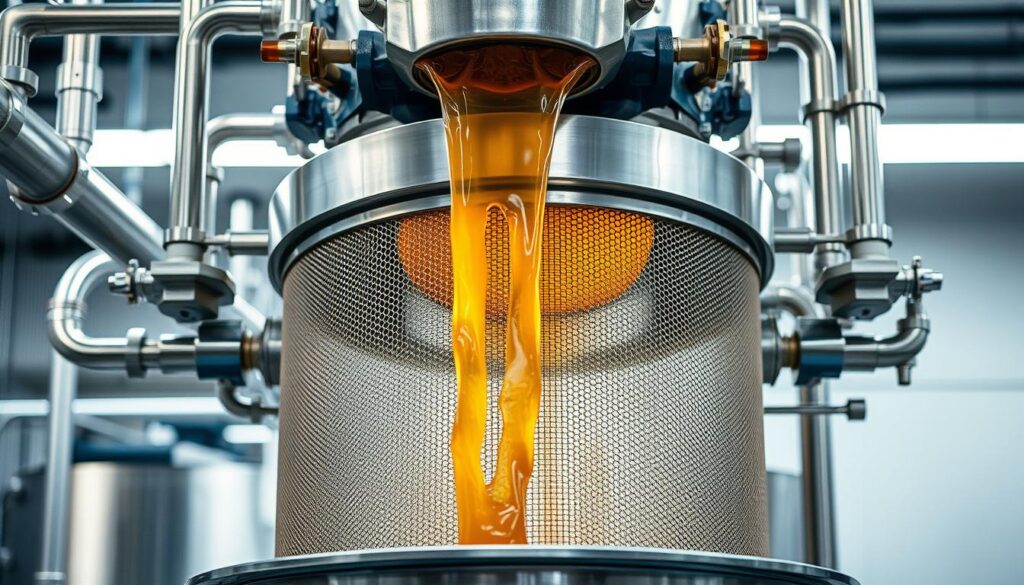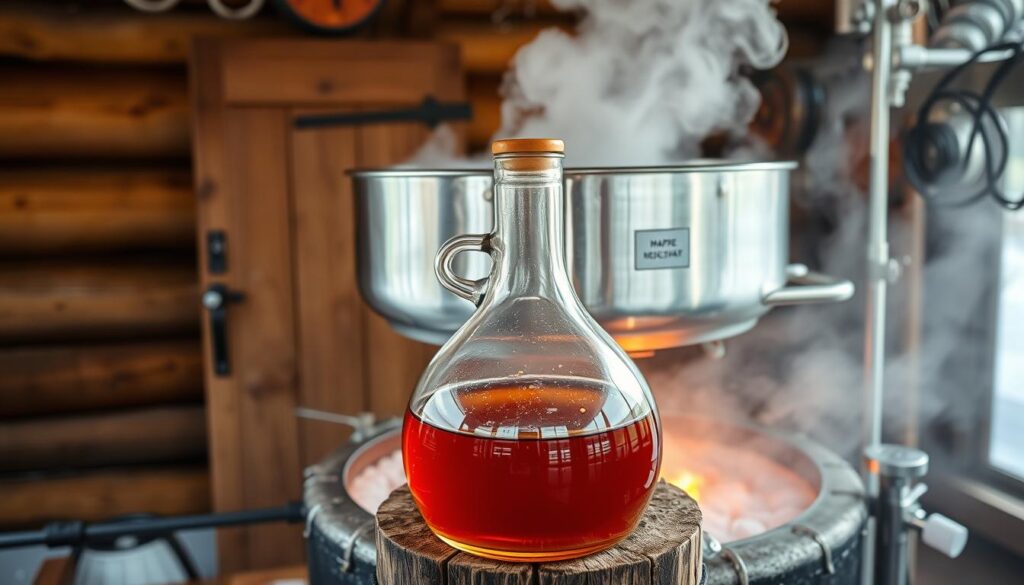Maple syrup production is a delicate craft. It turns raw tree sap into a golden, rich delicacy loved across North America. The Maple Syrup Separation Method is key to making high-quality syrup. It’s what sets a good syrup apart from an excellent one.
Every spring, maple trees in places like Vermont, New Hampshire, and Quebec offer their sap. This is a chance for skilled producers to make one of nature’s most beloved sweeteners. The process needs careful attention, technical knowledge, and a deep understanding of turning sap into syrup.
Successful maple syrup processing involves many stages. Producers must remove impurities, control temperature, and ensure quality. They filter and concentrate the sap carefully, watching each step to keep the syrup’s unique flavor.
This guide will show you the essential techniques of maple syrup separation. You’ll learn about sap collection, advanced filtration, and professional processing strategies. Whether you’re a hobbyist or an aspiring sugarmaker, these instructions will help you make exceptional maple syrup.
From understanding sap’s chemical makeup to using precise separation techniques, this guide covers it all. Readers will dive into the world of maple syrup processing. They’ll learn how to turn raw forest resources into a treasured culinary delicacy.
Understanding the Basics of Maple Syrup Processing
Maple syrup production is a complex and fascinating process. It turns raw tree sap into a sweet treat. The journey from forest to table involves many steps that need skill and precision.
Raw maple sap is special because of its chemical makeup. It’s mostly water with a bit of sugar and minerals. During processing, it changes into the rich, golden syrup we love.
Chemical Composition of Raw Maple Sap
The raw maple sap has several key components:
- Water (approximately 98%)
- Sucrose (primary sugar)
- Trace minerals like calcium and potassium
- Amino acids
- Organic acids
Why Separation is Essential
Separation is key in maple syrup production. It removes impurities and concentrates sugars. This ensures a high-quality syrup with the right flavor.
Key Components in Maple Syrup Production
Successful maple syrup processing involves several important components:
- Collection of raw sap
- Initial filtering
- Evaporation
- Concentration
- Final refinement
Each step requires precision and careful monitoring to transform simple tree sap into a premium culinary ingredient.
Required Equipment for Maple Syrup Separation
Getting the right equipment is key for making maple syrup. The Maple Syrup Separation Method needs special tools to turn sap into syrup. Sugarmakers use precise tools to make sure their syrup is top-notch.
Professional maple syrup makers use several important tools for separation:
- Large stainless steel collection tanks
- Commercial-grade evaporators
- Precision hydrometer
- Multi-stage filtration systems
- Temperature control devices
Each tool is vital for the syrup-making process. The tanks must be safe for food and big enough for lots of sap. Evaporators help make the sap sweeter by removing water.
| Equipment Type | Primary Function | Importance in Separation |
|---|---|---|
| Evaporator | Concentrate sap | Critical for reducing water content |
| Hydrometer | Measure sugar concentration | Ensures precise syrup density |
| Filter Press | Remove sediment | Guarantees syrup clarity |
The maple syrup filtration process needs special tools to make sap into syrup. Good tools mean syrup that’s always top quality.
Initial Sap Collection and Storage Techniques
Maple syrup production starts with careful sap collection and smart storage. Sugarmakers know that handling maple sap right is key to making great syrup. They need to be precise and pay close attention to every detail.
Collecting sap the right way is very important. It affects the syrup’s quality. Sugarmakers must be careful from the start, focusing on how to separate the sap from the raw syrup.
Best Practices for Sap Storage
Storing sap well is key to keeping its quality. Here are some tips to help:
- Collect sap quickly after tapping maple trees
- Use clean, food-grade containers
- Keep it away from contaminants
- Process sap within 24-48 hours of collection
Temperature Control Requirements
Keeping the right temperature is vital in making maple syrup. Sap needs specific conditions to stay good and prevent bacteria.
| Temperature Range | Storage Duration | Recommended Action |
|---|---|---|
| 32-38°F | Up to 7 days | Refrigeration recommended |
| Above 40°F | Less than 24 hours | Immediate processing required |
Container Selection Guidelines
Picking the right containers is important for effective sap storage. Food-grade materials prevent contamination and keep sap quality high.
“The right container can make the difference between exceptional and average maple syrup.” – Vermont Maple Sugar Makers’ Association
- Stainless steel containers preferred
- Avoid reactive metals like aluminum
- Ensure containers are thoroughly cleaned
- Use containers with tight-fitting lids
By using these exact methods for sap collection and storage, sugarmakers can make the best maple syrup from the start.
Pre-Separation Preparation Steps
Starting maple syrup production needs careful preparation. The process of clarifying maple syrup requires attention to detail before starting. Sugarmakers must set up an environment that ensures top-quality syrup.
Preparation for the Maple Syrup Separation Method includes several key steps:
- Sanitize all processing equipment thoroughly
- Check temperature and storage conditions
- Inspect sap for initial quality
- Prepare filtration materials
Getting equipment ready is vital for maple syrup processing. Experts suggest a detailed cleaning routine to remove contaminants:
| Equipment | Cleaning Method | Frequency |
|---|---|---|
| Collection Buckets | Hot water and food-grade sanitizer | Before each season |
| Filtering Screens | Boiling water rinse | Before and after use |
| Storage Containers | Sterilization with specialized cleaning solution | Before initial use |
Managing temperature is key in maple syrup processing. Fresh sap should be processed quickly to maintain optimal quality. Sugarmakers usually start processing within 24 hours to keep the syrup fresh and flavorful.
Professional maple syrup producers understand that preparation is 50% of successful production.
By following these steps, maple syrup producers can improve their product’s quality and consistency.
The Maple Syrup Separation Method: Primary Phase
The maple syrup separation method is key to making syrup from raw sap. Sugarmakers focus on this stage to produce top-notch syrup. They use special techniques to filter the syrup for the best taste.
Initial Filtering Process
First, maple syrup goes through a filtering step to get rid of big impurities. They use special tools to catch debris and unwanted stuff. The first steps in filtering are:
- Using fine mesh strainers to remove bark, leaves, and insects
- Employing pre-filter systems with progressively smaller filter sizes
- Ensuring clean collection containers before filtration
Temperature Management
Keeping the sap at the right temperature is very important. Sugarmakers watch the sap’s temperature closely. This helps keep the syrup quality high and stops bacteria from growing.
| Temperature Range | Purpose | Recommended Action |
|---|---|---|
| 32-40°F | Initial Sap Storage | Refrigerate or use immediate processing |
| 55-65°F | Initial Filtration | Begin separation process |
| 180-220°F | Boiling Phase | Concentrate syrup |
Timing Considerations
Timing is everything in maple syrup filtration. Experienced sugarmakers know every minute matters. Here are the usual times for each step:
- Initial filtering: 30-45 minutes
- Primary separation: 1-2 hours
- Final concentration: 20-30 minutes
By managing these times well, producers can turn raw sap into tasty maple syrup. This syrup shows off the skill of traditional craftsmanship.
Advanced Filtration Techniques

Professional maple syrup makers know that filtration is key to making top-notch syrup. They use advanced methods to improve the syrup’s clarity and purity. This step is vital for quality.
For the best syrup, makers use several advanced filtration methods:
- Membrane filtration systems
- Pressure-based filtering mechanisms
- Multi-stage filtration processes
- Temperature-controlled filtering techniques
Membrane filters are essential for removing tiny impurities. They can catch particles as small as 0.5 microns. This makes the syrup much better. Producers use these filters to get professional results.
Pressure filters are another smart way to filter syrup. They use pressure to get rid of sediment and minerals. This keeps the syrup’s flavor just right.
“The difference between good and exceptional maple syrup lies in meticulous filtration techniques.” – Maple Syrup Production Expert
Choosing the right filtration method depends on a few things. These include how much syrup you make, how clear you want it, and what equipment you have. Small makers might stick to manual methods. But bigger ones often use automated systems.
Managing Sediment Removal
The maple syrup separation method needs careful attention to sediment management. Sediments can greatly affect the syrup’s quality and taste. So, removing them effectively is key to making top-notch maple syrup.
Understanding the types of particles that form during production is important. These particles can ruin the syrup’s smooth texture and pure flavor.
Types of Common Sediments
- Sugar Sand (Niter): Mineral-rich deposits that naturally form during boiling
- Calcium Carbonate Crystals
- Organic Debris from Tree Bark
- Microscopic Plant Particles
Effective Removal Strategies
Professional sugarmakers use various methods to remove sediment. This ensures their syrup is clean and of high quality.
| Removal Method | Effectiveness | Complexity |
|---|---|---|
| Gravity Filtration | Moderate | Low |
| Pressurized Filtering | High | Medium |
| Multi-Stage Filtration | Very High | High |
The Maple Syrup Separation Method requires precision in removing sediments. Sugarmakers use finer filters to catch different particle sizes. This ensures the syrup is crystal clear.
Proper sediment removal is not just about clarity—it’s about preserving the maple syrup’s delicate flavor profile.
Quality Control Measures During Separation

Maple syrup quality control is key to making top-notch syrup. Sugarmakers pay close attention to detail during separation. This ensures the syrup is of the highest quality.
For the best syrup separation, a careful quality management plan is needed. Skilled producers use several important methods to check their work.
- Density Testing: Using a hydrometer to measure sugar concentration
- Color Grading: Assessing syrup shade and clarity
- Flavor Evaluation: Detecting subtle taste variations
- Sanitation Monitoring: Preventing possible contamination
The quality control process for maple syrup has many important steps. Producers check each stage of separation carefully. They do this to keep the syrup consistent and meet high standards.
| Quality Control Parameter | Evaluation Method | Acceptable Range |
|---|---|---|
| Brix Measurement | Hydrometer Reading | 66-67 Brix |
| Color Classification | Visual Inspection | Golden, Amber, Dark |
| Microbial Safety | Laboratory Testing | Zero Contamination |
Precision and consistency are what make maple syrup special. By following strict quality control steps, sugarmakers turn raw sap into a luxury food item.
“Quality is never an accident; it is always the result of high intention, sincere effort, and skillful execution.” – Maple Syrup Artisan
Common Challenges and Troubleshooting
Maple syrup making needs precision and careful attention. Sugarmakers face specific challenges during separation that can affect the syrup’s quality. Knowing these issues helps ensure a smooth production process.
When learning to separate maple syrup, producers must be ready for two main challenges: clarity and temperature issues.
Addressing Clarity Issues
Clarity is key in maple syrup making. Cloudiness or sediment can lower the syrup’s quality and market value. Sugarmakers can solve these problems with several strategies:
- Use multiple-stage filtration systems
- Implement pre-filtering techniques
- Carefully monitor sap collection conditions
- Invest in high-quality filtering equipment
Temperature-Related Problems
Temperature control is essential in maple syrup separation. Inconsistent temperatures can cause problems in the final product.
| Temperature Challenge | Potential Solution |
|---|---|
| Uneven boiling | Use precise heat control equipment |
| Inconsistent syrup density | Maintain consistent boiling temperatures |
| Crystallization risks | Monitor and adjust heating process carefully |
Successful maple syrup making combines technical knowledge and practical experience. By understanding these common challenges, producers can develop strategies to minimize issues and create high-quality syrup.
Professional sugarmakers know that attention to detail makes all the difference in maple syrup production.
Storage Solutions After Separation
Maple syrup production needs careful storage to keep its quality and taste. After separating the syrup, producers must use the right methods to keep it fresh. This includes protecting it from contamination and spoilage.

Choosing the right containers is key to keeping maple syrup fresh. Glass and food-grade stainless steel containers are best. They prevent flavor contamination and bacterial growth.
- Clean containers thoroughly before storing maple syrup
- Use airtight seals to prevent moisture intrusion
- Store in cool, dark environments
Keeping the syrup at the right temperature is important. Store it at 40-45°F to stop spoilage and crystallization. This is part of the best practices for maple syrup separation.
| Storage Container | Recommended Duration | Temperature Range |
|---|---|---|
| Glass Jar | 12-18 months | 40-45°F |
| Stainless Steel Container | 18-24 months | 38-42°F |
Proper labeling is important. Use waterproof labels and include the harvest date to ensure optimal tracking of your maple syrup production.
Pro tip: Always store maple syrup in smaller containers to minimize repeated temperature changes and prevent contamination.
Professional Tips for Optimal Results
Mastering maple syrup separation is more than just knowing the basics. Experienced sugarmakers have developed advanced techniques. These techniques can greatly improve production quality and efficiency.
Professional maple syrup producers know that successful clarifying techniques are more than just standard methods. They suggest a multi-step approach for the highest quality final product.
Expert Recommendations for Maple Syrup Production
- Invest in high-quality filtration equipment
- Monitor sap temperature consistently
- Use multiple filtration stages
- Clean equipment thoroughly between batches
Time-Saving Maple Syrup Clarifying Techniques
| Technique | Time Saved | Quality Impact |
|---|---|---|
| Pre-filtering sap | 30-45 minutes | Increased clarity |
| Automated temperature control | 1-2 hours | Consistent syrup quality |
| Bulk filtering system | 2-3 hours | Reduced manual labor |
Professional sugarmakers stress the importance of precision and patience in maple syrup separation. Even small changes in technique can make a big difference in efficiency and product quality.
“The difference between good and exceptional maple syrup lies in the details of separation.” – Vermont Maple Sugar Makers Association
By following these professional tips, maple syrup producers can make their separation process more efficient. They can also reduce waste and create a superior product that will stand out in the market.
Environmental Considerations and Sustainable Practices
Maple syrup production is a balance between old ways and caring for the environment. Sugarmakers now see how important it is to protect the maple forests. They want to keep the forests healthy and reduce harm to nature.
The Maple Syrup Separation Method is key to making production greener. Sustainable methods cover a few main points:
- Forest Conservation: Keeping maple tree ecosystems safe
- Energy-Efficient Evaporation: Lowering carbon emissions
- Responsible Sap Collection: Reducing stress on trees
- Waste Management: Using recycling
Today’s maple syrup makers use new ways to lessen harm to the environment. Precision tapping keeps trees healthy. New evaporation tech cuts down energy use during the process.
“Sustainability isn’t just an environmental goal—it’s a commitment to future generations of maple syrup production.”
Keeping biodiversity is a big deal. Sustainable maple syrup helps forests stay diverse. It protects maple trees and all woodland life. Sugarmakers use smart management to keep their forests and the area around them healthy for a long time.
More people want food made in ways that are good for the planet. This makes sustainable maple syrup a popular choice. Producers who focus on the environment stand out and help protect nature.
Modern Technologies in Maple Syrup Processing
The world of maple syrup processing has changed a lot with new technologies. Digital systems and automated tools are making sugarmaking more precise and efficient. This is a big change from old ways of making maple syrup.
Now, maple syrup making uses advanced digital systems. These systems give real-time updates on important production details. This lets producers track and manage syrup making with great accuracy.
Digital Monitoring Breakthroughs
Modern digital systems track maple syrup production in detail:
- Real-time temperature monitoring
- Precise density measurement
- Automated flow rate tracking
- Instant quality assessment
Automated Separation Equipment
New automated tools have changed maple syrup making. These tools cut down on manual work and make production more consistent.
“Technology is reshaping maple syrup production, making it more efficient and precise than ever before.” – Maple Innovations Research Institute
Important advancements in maple syrup making include:
- Reverse osmosis systems
- Advanced filtration technologies
- Computer-controlled evaporation units
- Smart sensors for quality control
By using these modern tools, sugarmakers can make their work more efficient. They can also improve the quality of their syrup and make their operations more sustainable.
Conclusion
Maple syrup production is a mix of old ways and new tech. It needs careful steps to turn sap into syrup. Every part of the process is important for making syrup that’s sweet and pure.
Success in making maple syrup comes from paying close attention. Sugarmakers use both old and new methods to make syrup that’s the best. The process is a skill that needs constant learning and improvement.
Those new to or experienced in maple syrup making can do well by learning the right techniques. It doesn’t matter if you’re on a small farm or a big operation. The main thing is to focus on quality, try new things, and honor the sap’s natural taste. Making maple syrup is a journey of learning, passion, and loving nature’s sweet gifts.
By using the tips and knowledge from this guide, producers can make their syrup stand out. The journey to making great maple syrup is filled with learning, practice, and a deep love for this ancient craft.



